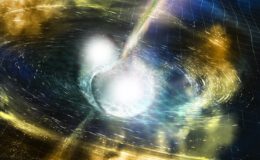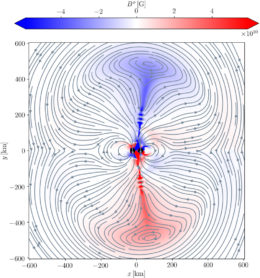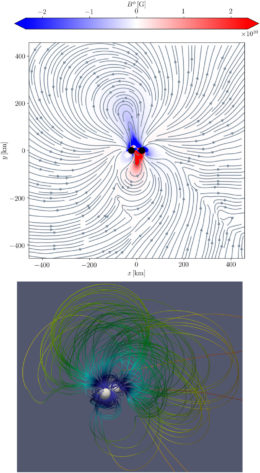We know that when two neutron stars — the dense, compact cores of evolved stars — collide, they produce signals that span the electromagnetic spectrum. But could these binaries also flare before they merge, as well?
A Broad Range of Signals

Artist’s impression of the collision and merger of two neutron stars. [NSF/LIGO/Sonoma State University/A. Simonnet]
But emission might not be restricted to during and after the merger! A new study conducted by two researchers from the Flatiron Institute, Elias R. Most (also of Goethe University Frankfurt, Germany) and Alexander Philippov, explores the possibility that neutron star binaries may also produce flares of emission in the time leading up to their final impact.

This plot of the out-of-plane magnetic field density indicates the twist in flux tubes connecting the two neutron stars seen at the center of the plot. Here, an electromagnetic flare is launched from the binary after a significant twist has built up due to relative rotation of the right star. [Most & Philippov 2020]
What About Magnetic Fields?
In particular, Most and Philippov focus on how the magnetospheres of the two neutron stars — the magnetized environment surrounding each body — interact shortly before the objects collide.
The authors conduct special-relativistic force-free simulations of orbiting pairs of neutron stars in which each star is threaded with the strong dipole magnetic field expected for these bodies. The simulations then track how the stars’ magnetic fields evolve, twist, and interact as the bodies orbit each other.
A Twisted Fate
Most and Philippov find that dramatic releases of magnetic energy are a common outcome if the neutron stars orbit close enough to one another that their magnetospheres interact.
The authors show that the brightness of the flare luminosity depends only on how far apart the neutron stars are in the simulation: the smaller the separation, the brighter the flare. This dependence demonstrates that the flaring events are driven primarily by the energy stored in the twisted tube of magnetic flux that forms connecting the two neutron stars.

Here, the twisted flux tube and resultant flaring is caused by orbital motion of 45° misaligned magnetic fields, rather than by one star spinning. The bottom panel shows a 3D visualization of the field line configuration at the time of flaring. [Most & Philippov 2020]
Look for Radio Clues
So can we observe these sudden releases of energy? Most and Philippov argue that we should be able to spot the drama in radio emission: a radio afterglow will be produced behind the magnetized bubble that’s ejected from the twisted loop, and additional radio emission can be produced when the bubble collides with surrounding plasma.
Future work on this topic will explore the impacts of the neutron stars’ inspiral, and how the interactions of the magnetospheres change when the neutron stars carry unequal charge. The current study, however, indicates it’s worth keeping a radio eye out to see if we can spot signs of collisions to come!
Citation
“Electromagnetic Precursors to Gravitational-wave Events: Numerical Simulations of Flaring in Pre-merger Binary Neutron Star Magnetospheres,” Elias R. Most and Alexander A. Philippov 2020 ApJL 893 L6. doi:10.3847/2041-8213/ab8196


1 Comment
Pingback: Señales de las colisiones futuras – Observatori Astronòmic